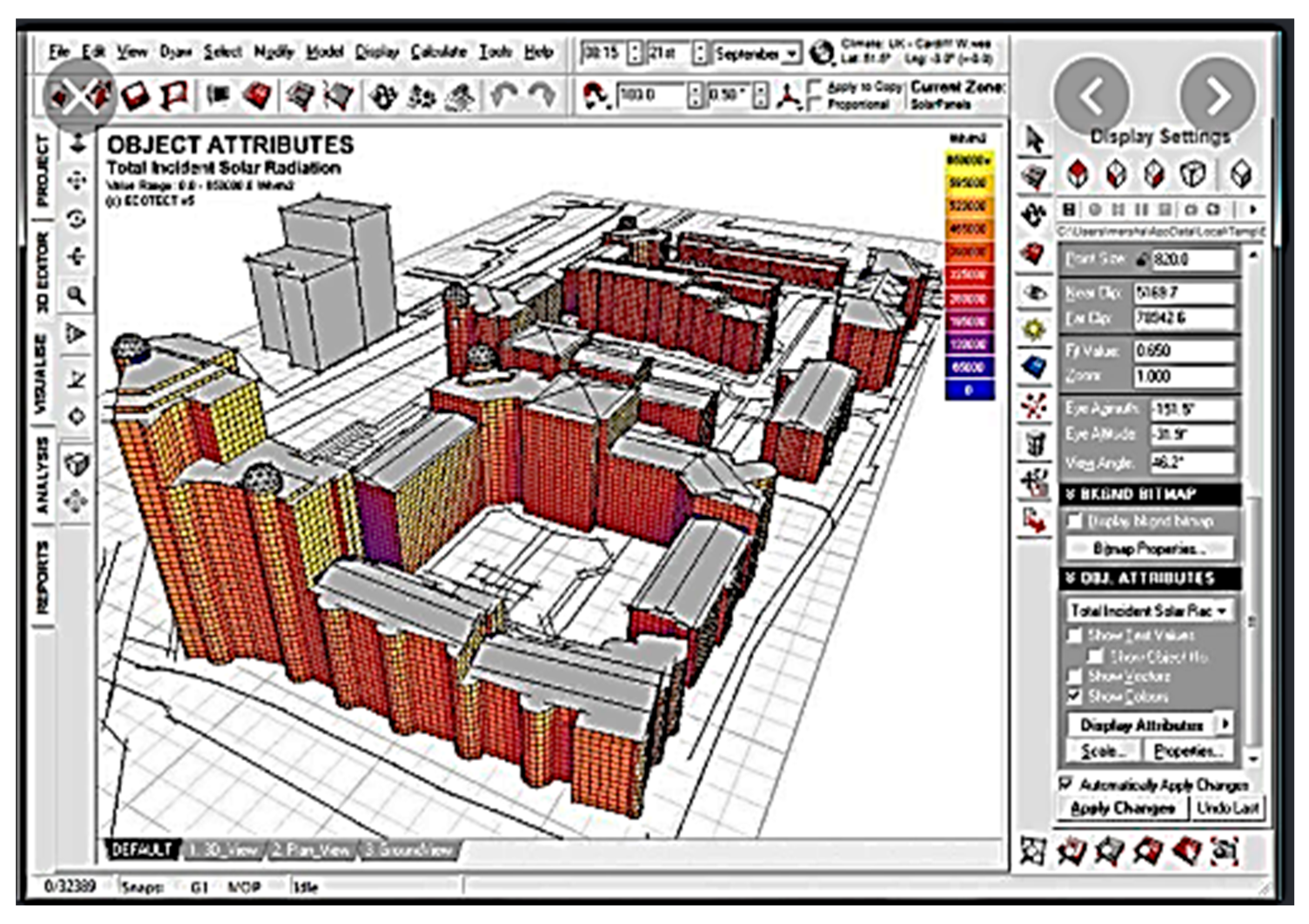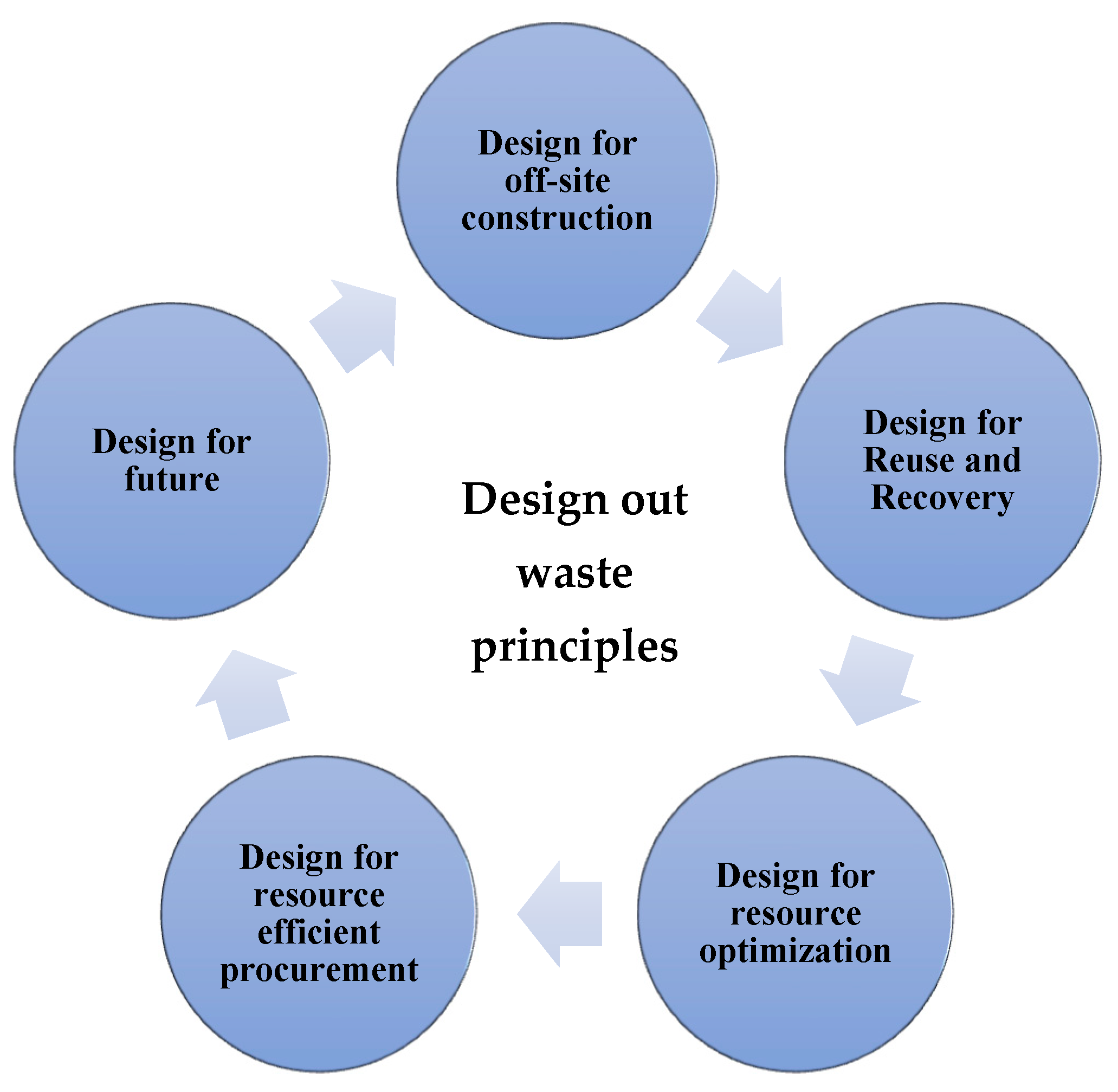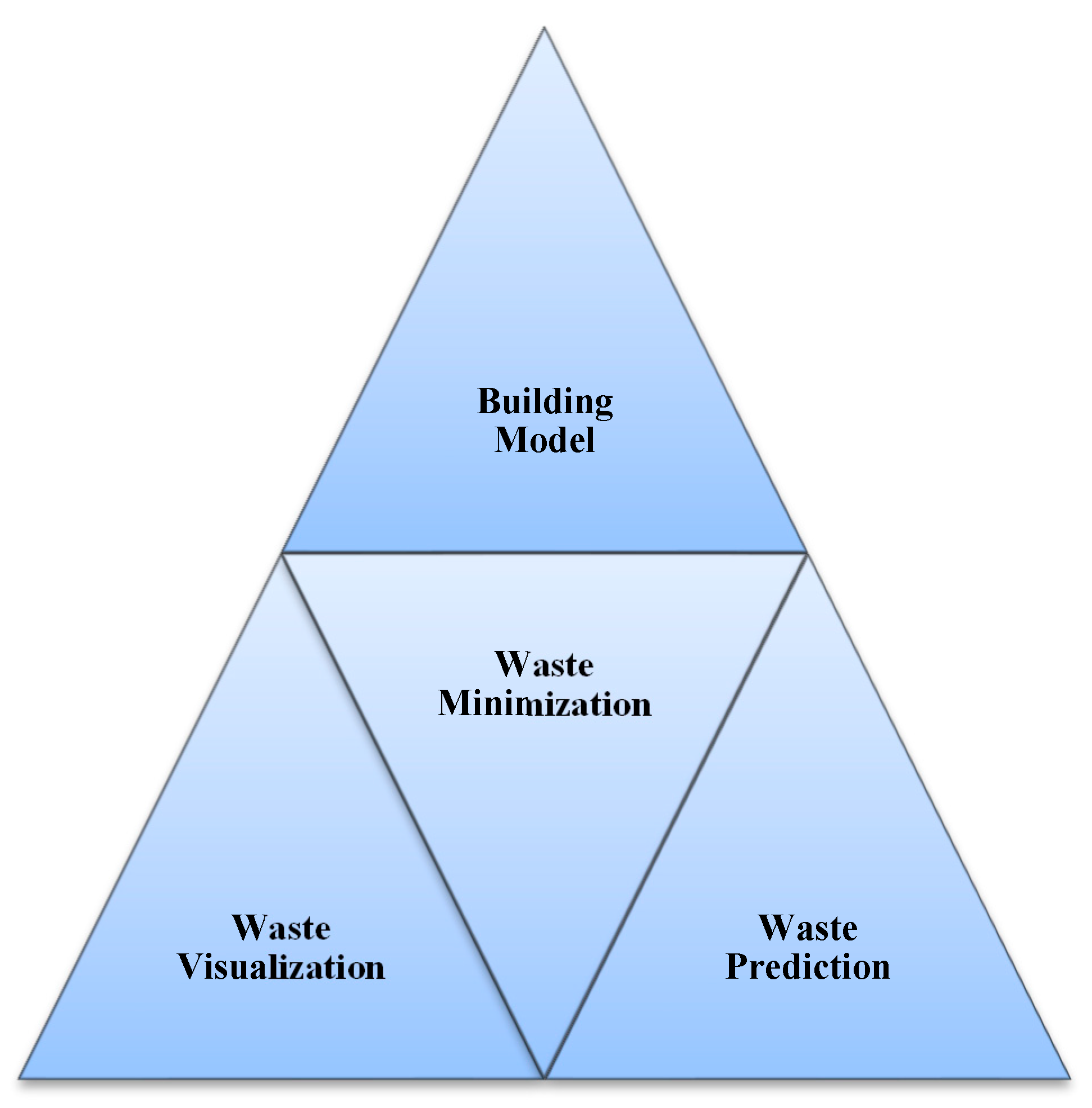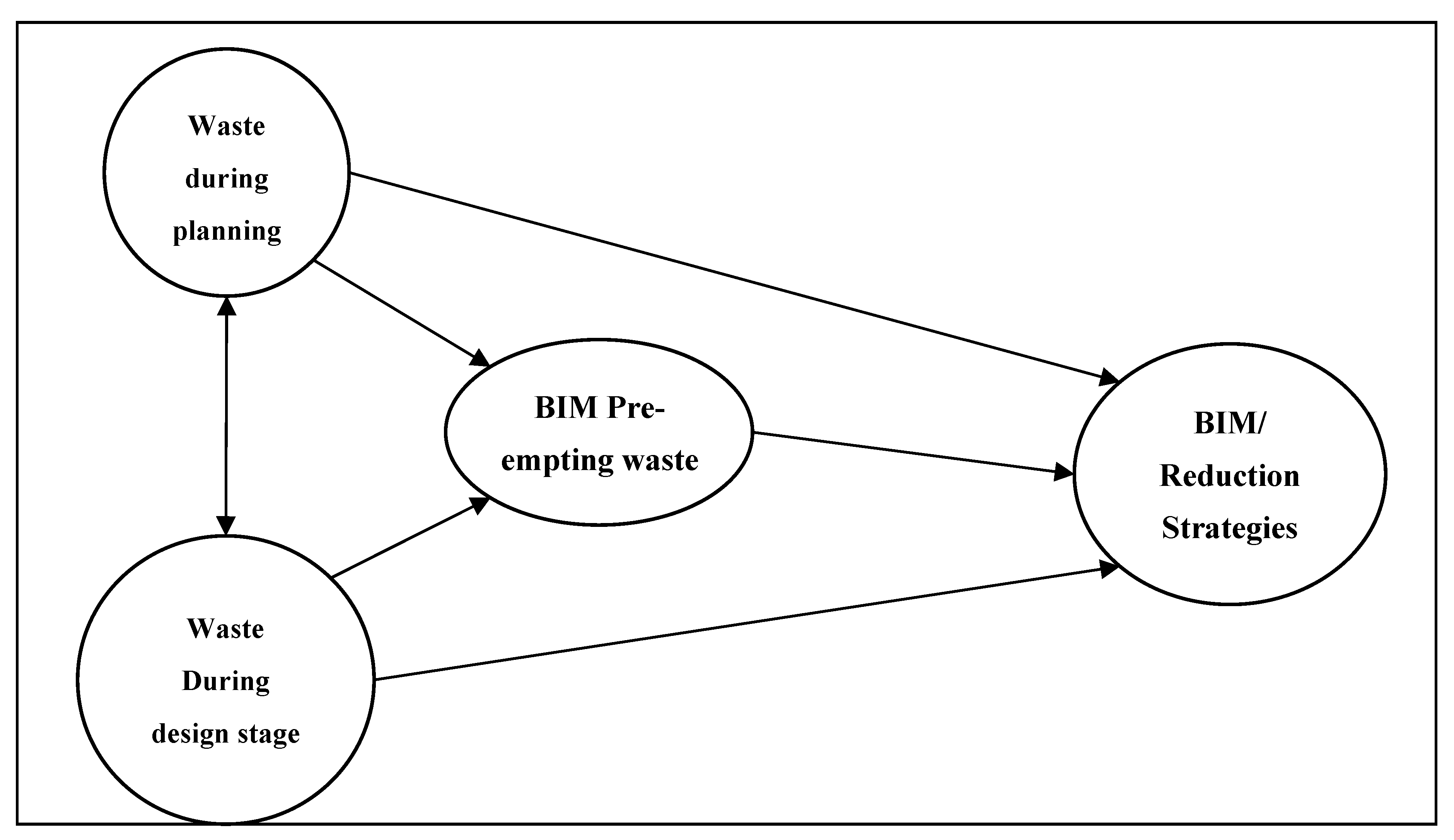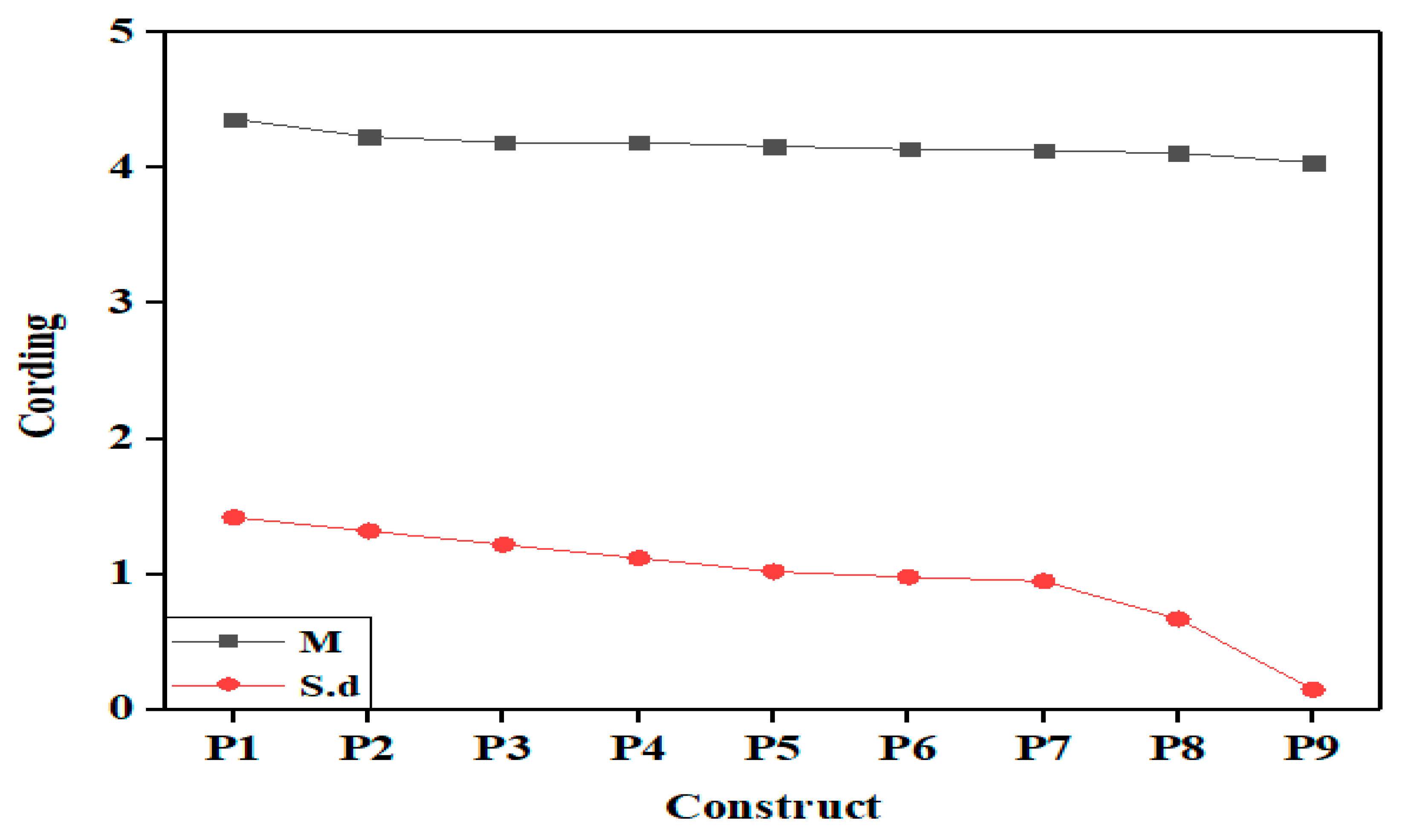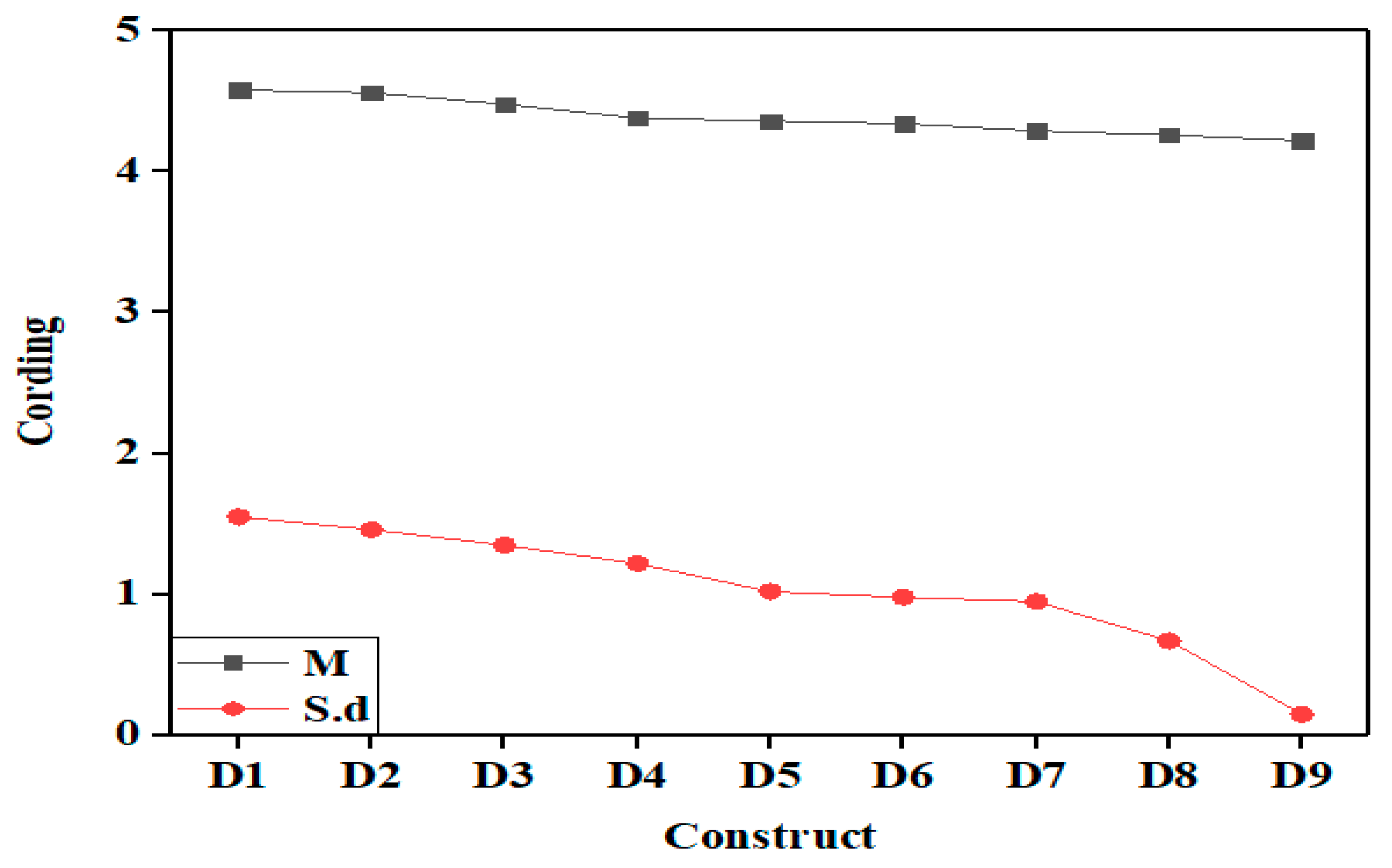The reliability test for all the constructs was carried out using Cronbach’s alpha, as suggested by [
73]. Statistical analysis was used in the study to test the relationship between the parameter and was also used to test the instrument’s reliability. The questionnaire was pretested by giving copies for correction to 10 professionals. The study’s constructs were all tests. They were all found to be reliable, as shown in
Table 3 below, excluding a few variables that were removed to enhance efficiency and effectiveness. As a result, the inter-item correlation matrix study indicated a relationship between variables with a correlation r greater than 0.30, as recommended. The Cronbach’s alpha result is shown in
Table 3. Despite the increasing adoption of BIM in building design, most existing waste management tools are not compliant with BIM. This is because these tools are external to the BIM software used by designers, thereby limiting their usability. Ge [
74] noted the tools out of those existing that were compliant with BIM. This fact reveals a huge gap in knowledge, since evidence in the literature suggests that effective waste minimisation must start from the design stage, and this can only be achieved if waste management functionalities are incorporated into design tools. The above-listed factors have impeded the exploitation of the capabilities of BIM software for the analysis of CDW at the planning and design stage.
However, professionals and workers in the Malaysian construction industry engaged in a questionnaire study. The questions were designed to determine the benefits of implementing BIM at the planning and design stage of a building. The 340 questionnaires were given to various actors in the Malaysian construction industry for this purpose, with an 89% response rate. A total of 302 questionnaires were used in the study after the quality of responses was evaluated. Missing data and incorrect postings were identified using frequency analysis. Before completing CFA, the dysfunction factors were identified using confirmatory factor analysis (CFA). In the study of the answers to the questions asked in the questionnaire, a descriptive analysis was carried out to investigate the normality of the data, as recommended by Zahoor et al. 2017 [
75]. The results indicated that in the planning and design phase, a Cronbach alpha value of 0.889 was obtained for planning and design, with 0.900 indicating the beneficial effects of BIM for pre-emptive waste minimisation. Therefore, according to [
50], the measurement model met the reliability and validity criteria for the latent and observed variables.
Table 3 shows the ranks and statistical parameters for 19 design-influencing elements (P1 to 19).
4.1. Ranking of Factors for Pre-Emptive Waste during the Planning
The first factor among ranking 19 variables of pre-emptive waste during planning is Feasibility Analysis, which was among the construct (P1) that BIM can pre-emptively minimise waste during the planning stage. Feasibility Analysis was ranked as the first factor that can benefit BIM in reducing waste during the planning stage by the respondents, with a score of 4.36. As a result, the conclusion from this study is the same as the conclusion of the previous study by Al Hattab and Hamzeh [
76]. As illustrated in
Table 4 and
Table 5, the BIM 360 environment allows users to collaborate on project templates and coordinate planning, ensuring that all design stakeholders know the project’s progress and outcome.
Better Collaboration and Communication (P2) had a 4.23 mean as the factor having ranked second among the factors that have a beneficial effect on BIM for pre-emptive waste minimisation during the planning stage. Better Collaboration and Communication (P2) BIM models allow paper drawing sets to be shared, collaborated on, and versioned to minimise waste during the planning and design stage. This consequence is the same as [
77,
78]. The BIM 360 platform enables teams to share project templates and plan ahead of time, ensuring that all design stakeholders are fully prepared. Estimation of Cost Using a Model (P3) is one of the factors in the study that can benefit BIM in pre-emptive waste reduction during the building planning stage in the study area, with an average mean of 4.19. It was rated as the third best factor that can benefit BIM in pre-emptive waste reduction during the building planning stage in the study area. The result is aligned with the prediction [
57]. Three-dimensional Modelling BIM provides outstanding precision, but only when data are incorporated in the pre-emptive effective waste management model with the required level of detail.
Improve Coordination Clash Detection (P4) was the next factor among the BIM during the planning stage of construction, ranked fourth, which had a 4.19 mean. Improve Coordination Clash Detection (P4) is used to look for conflicts before construction. Improved Coordination Clash Detection (P4) based on BIM enables problems to be fixed before construction, saving time and money. This result is the same as [
79]. More efficient collision detection, once again, requires a higher level of control. Scheduling/Sequencing (P5) was ranked fifth in a study for pre-emptively reducing waste during the planning stage, with a mean score of 4.16. Companies utilise particular scheduling strategies in the design stage based on Scheduling/Sequencing (P5) in the planning stage. The most prevalent methods include bar charts, Gantt charts, and the Critical Path Method (CPM). Scheduling/Sequencing (P5) enables construction components to be linked in 3D models and activities in the schedule, forming a 4D model for reducing waste during the building design stage. This result is the same as the result of Politi [
57], who showed that schedules can be planned more accurately and communicated precisely. Improved coordination helps projects to become more likely to be completed on time or early by minimising the time wasted.
Table 4 shows the 17 planning influencing factors (P1 to P17). These factors were used in the study. Meanwhile, the planning and design principles go beyond building element selection. Other studies have shown that building design methodology and design documentation [
80] are all part of planning and design principles. This study, however, is limited to key planning and design principles required in building elements’ selection, as presented in
Table 4.
BIM-based Cost Estimation (5D) (P7) for pre-emptive waste minimisation had a mean of 4.11 in the research findings among the factors that can minimise waste in a building’s planning and design phase. If sustainability analysis is not performed in the early planning stages, it becomes difficult and costly to meet performance requirements. Moreover, using BIM technology, sustainability and performance analysis can be conducted during a building’s planning and design stage. The model’s fundamental goal is to reduce carbon footprints and eliminate waste during planning and design. This result aligns with [
81,
82]. The main factor is the consistent collection and analysis of the data and updating of the BIM model. Likewise, the Sustainability (P7) had a mean of 4.04 as a factor ranked seventh in the study area during a building’s planning and design process under waste minimisation. During the planning and design phase, the BIM execution plan (BEP) covers executing, monitoring, and controlling BIM technology steps and reducing wastage. Each strategy is unique to each project, but it is critical for planning and coordinating project deliverables to decrease waste during the planning and design process. It also provides crucial success indicators that may be used to track development [
57,
83]. This outcome is consistent with having a likelihood of success and optimising efficiency throughout the project lifecycle and beyond.
4.2. Ranking of Factors for Pre-Emptive BIM for Waste Minimisation during the Design Stage
The factor of Prefabricated components (D1) with a mean of 4.56 was stated to have been ranked first in the beneficial effects of BIM for pre-emptive waste minimisation during the design stage of a building. The respondents can effectively pre-emptively reduce waste during the planning and design stage of construction. By integrating Prefabricated components (D1) into the design, the survey results on Prefabricated components (D1) could enhance productivity. This result confirmed the findings of a survey conducted by [
23,
84,
85]. BIM data could be used to efficiently develop design drawings or databases, allowing prefabrication and modular building methods to be used more widely. D2 had the second-highest mean rating of 4.36 for fewer design revisions. As a result, it is vital to enhance incentive schemes to motivate designers and predict their performance in environmental design by adopting them. The factor of less design modification (D2) can effectively imprint BIM for depreciation and waste prevention during the planning and design process of a building for a better design. These issues are undoubtedly the most significant obstacles in project design that prevent sustainable solutions from being appropriately implemented [
86,
87]. This finding is consistent with the results in [
88].
Waste reduction investment (D3) received the third-highest rating of 4.33. Investment in construction waste management can help this factor effectively imprint BIM for pre-emptive waste minimisation during the planning and design stage of a building’s promote waste management practices in construction. This is the same as the outcome of Sibanda [
89], because economic benefit is the primary goal of different participants in the building process. The surveys suggested the government should encourage the environmental efficiency of a construction company through a more focused certificate that can comprehensively analyse the capacity by enhancing BIM design for pre-emptive waste minimisation during a building’s planning and design process. Modular design (D4) had the fourth-highest importance of 4.38. Modular construction speeds up building, increases efficiency, and reduces waste and energy. For instance, shear walls pose disincentives due to the high cost and a large amount of cutting waste. Modular design is an approach designed to assist designers in identifying areas for improvement. Modular design BIM reduces pre-emptive waste during a building’s planning and design phase. This result is in line with that discussed in the literature [
90,
91]. It is stated that modular construction and modular design could reduce waste generation from the construction, as manufacturing is carried out in factories and is highly applicable in densely populated Malaysian buildings. The fifth-highest mean importance rating of 4.36 was economic incentive (D5). Different motivational and compensation systems are successful, and in the construction industry, a performance-dependent monetary reward system is used.
Nonetheless, enhanced incentive mechanisms are therefore required to inspire design organisations to improve their performance in environmental design. This finding is in line with the report by [
18,
92]. Rewarding and penalising methods concerning on-site material handling have been used effectively in construction sites through special motivational and financial incentive programs to enhance BIM for pre-emptive waste minimisation during the planning and design stage.
Table 5 presents the ranking of factors of BIM for waste minimisation during the design stage.
As a factor that can improve BIM for pre-emptive waste minimisation during the planning and design stage, large-panel metal formworks (D6) received the sixth-highest mean rating of 4.34. Wood formwork is extensively utilised to manufacture cast concrete structures due to its flexibility and ease of handling. The respondent stated that building methods for formworks, such as their scale, handling, and reuse or recycling possibilities, should be considered early in the design stage for formwork waste reduction.
Designers can make it possible for other projects to use metal formworks, such as steel aluminium, which is durable, recyclable as scrap, and reusable on-site and at other sites to mitigate waste, and would use BIM for pre-emptive waste minimisation during the design stage of a building. This result was supported by Fang [
93]. However, line graphs were used to show the significance between quantitative variables with nine significant factors when the independent variables were under waste minimisation during the planning and design stage. Each point in a line graph represents the mean score of the dependent variable based on the highest value of the independent variable in this study. With an average mean of 3.37 and a standard deviation of 0.46, the design for recycled metals such as recycled aggregates (D19) is placed 19th. Therefore, the lowest of the nineteen characteristics that benefits BIM in pre-emptive waste minimisation during the design stage is design for recycled metals such as recycled aggregates (D19). The link between standard deviation and the statistical parameters is shown in
Figure 5 and
Figure 6.
Table 6 shows the results of the relationship between BIM and waste minimisation predicted during the planning and design stages of a building. The most important factors in reducing waste throughout the construction planning and design stage based on the respondents’ findings showed that normal distribution with skew and kurtosis had acceptable values between 1.49 and 0.12. The scope of ±2 was used as recommended by George and Mallery [
94]. Furthermore, the reliability test was carried out to measure the reliability of the constructs.
The result in this case indicated the value was R
2 = 0.163,
f (1, 99) = 19.220,
p < 0.001. The independent variables, the beneficial effects of BIM for pre-emptive waste minimisation, explained 16.3% medium significance (
p < 0.001). The R
2 level just represented the predictive accuracy of the model. Consequently, small R-squared values are not always a problem [
95]. However, R
2, even when small, can be significantly different from 0, which would indicate that a regression model has statistically significant explanatory power [
96]. Therefore, hierarchical multiple regressions were used to evaluate BIM and waste minimisation during the planning and design stage. The analyses were performed to guarantee that normality, linearity, multicollinearity, and homoscedasticity assumptions were not violated. The results are presented in
Table 7.
However, regression analysis was conducted to evaluate the connection variables in the study area. The table below,
Table 8, contains the results of the analysis of the variable that drives the effect of BIM for pre-emptive waste minimisation during the planning and design stage of a building. The outcome proves a substantial and positive correlation between BIM and waste minimisation variables during the planning and design stage; R = 0.596.
Minimisation during the planning and design stage of a building was entered at step 1, explaining 0.355,
f (1, 99) = 54.464,
p < 0.001 of the beneficial effects of BIM for pre-emptive waste minimisation during the planning and design stage of a building. The model’s complete variance was described as 0.356,
f (2, 98) = 27.141,
p < 0.001. The r-squared value r
2 = 0.356, f (2, 98) = 27.141,
p < 0.001 shows that the independent variables explained 35.6% large significance (
p < 0.001) minimisation during the planning and design stage of a building, and in terms of reduction strategies, an additional 2% was insignificant; R-squared change = 0.002,
f change (1, 98) = 0.238,
p = 0.627. However,
Table 9 further assesses the relationship between the independent and dependent variables.
The result shows that the variable with the most considerable beta value in the standardised coefficients was 0.564 for waste minimisation during the planning and design stage. In contrast, the variance explained by the waste in the BIM effect variable in the model was controlled. The results show that waste minimisation during the planning and design stage variable made a significant (p < 0.001), unique contribution to pre-empting waste during the planning and design stage and reduction strategies. In contrast, the BIM effect variable had the lowest negative beta value of −0.051 and insignificant (p = 0.627) contribution in explaining the dependent variable waste minimisation during the planning and design stage for better results.
In summary, this research found that BIM for pre-emptive waste minimisation during the planning and design stage and reduction strategies is a significant determinant for improving efficiency. D1 was ranked first and D9 was ranked last under the variables on waste minimisation during the design stage. P1 in the first research region and P9 were ranked last under the factors of waste minimisation during the planning stage. There was a significant and positive correlation between the two factors of the effects of BIM for pre-emptive waste minimisation during the planning and design stage of a building, which explained 16.3% medium significance (p < 0.001). The planning and design stage with a neighbourhood explained 35.6% great significance (p < 0.001), which was effective in BIM. Additionally, the waste minimisation during the planning and design stage explained an additional 2% insignificant and negligible effectiveness construction. The BIM for pre-emptive waste minimisation during the planning and design stage of a building variable made a statistically significant (p < 0.001), unique contribution, with the most considerable beta value in the standardised coefficients (0.564) in BIM for pre-emptive waste minimisation during planning and design stage and in reduction strategies in the Malaysian construction industry.
